APTE7105 Industry Investigation: Solar Energy Tracking System Project
VerifiedAdded on 2021/05/30
|11
|1876
|66
Project
AI Summary
This project proposal outlines the development of a solar panel charging system with a tracking system to enhance electricity generation efficiency. The project utilizes an Arduino device for the tracking system and Multisim for circuit simulation. The rationale emphasizes the potential of solar trackers to increase energy production by automatically adjusting to sunlight, addressing Auckland's rising energy demand and the need for energy efficiency. The aim is to design a solar energy tracking system using Arduino and a charging system circuit, leading to a prototype for testing and modification. The literature review covers various types of sun trackers, advantages, and disadvantages. The project also addresses research questions about the components and the scope includes research outputs and a prototype design. References include sources on solar tracking, Arduino, and related technologies.
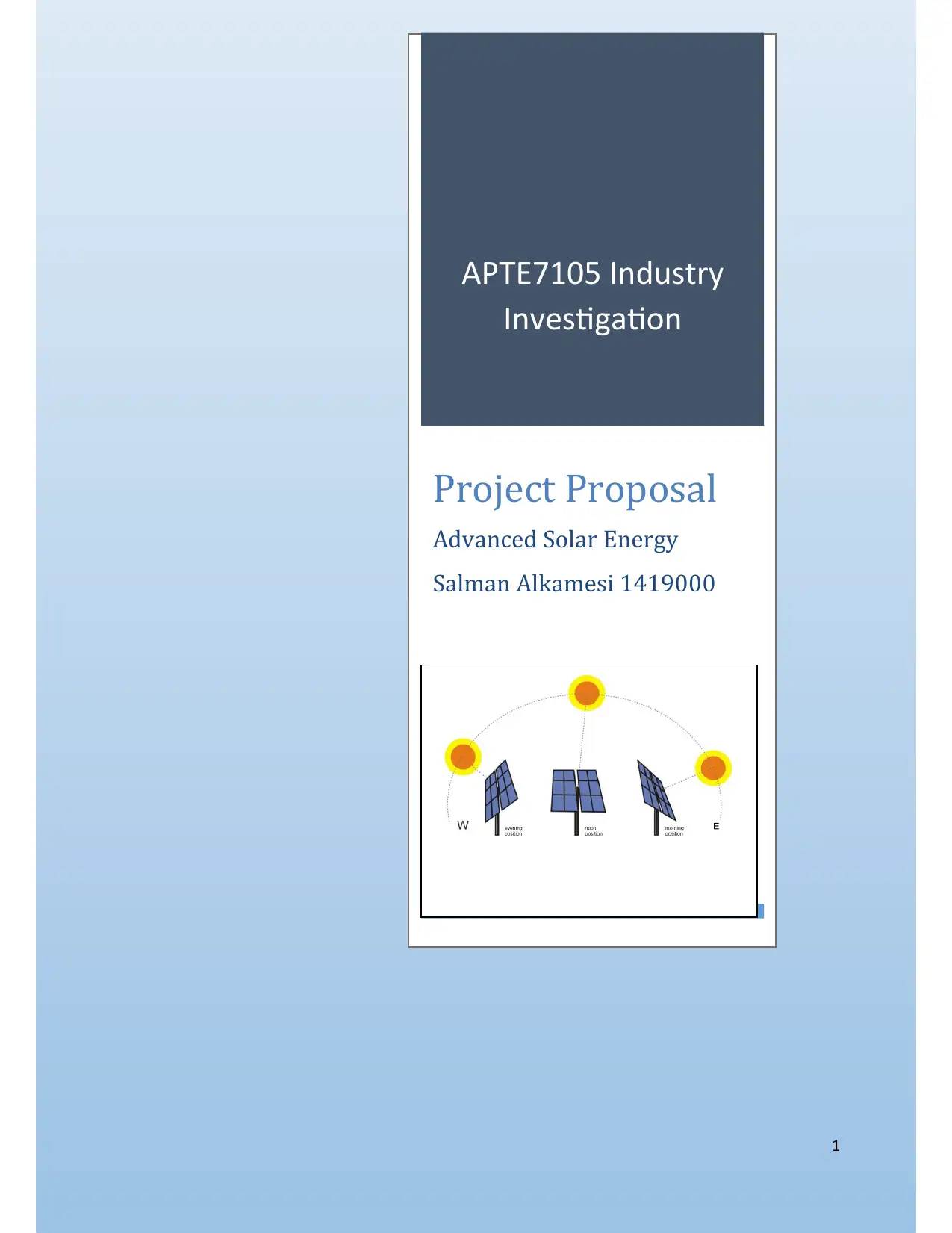
1
APTE7105 Industry
Investigation
Project Proposal
Advanced Solar Energy
Salman Alkamesi 1419000
salman
Salman Alkamesi 1419000
APTE7105 Industry
Investigation
Project Proposal
Advanced Solar Energy
Salman Alkamesi 1419000
salman
Salman Alkamesi 1419000
Paraphrase This Document
Need a fresh take? Get an instant paraphrase of this document with our AI Paraphraser
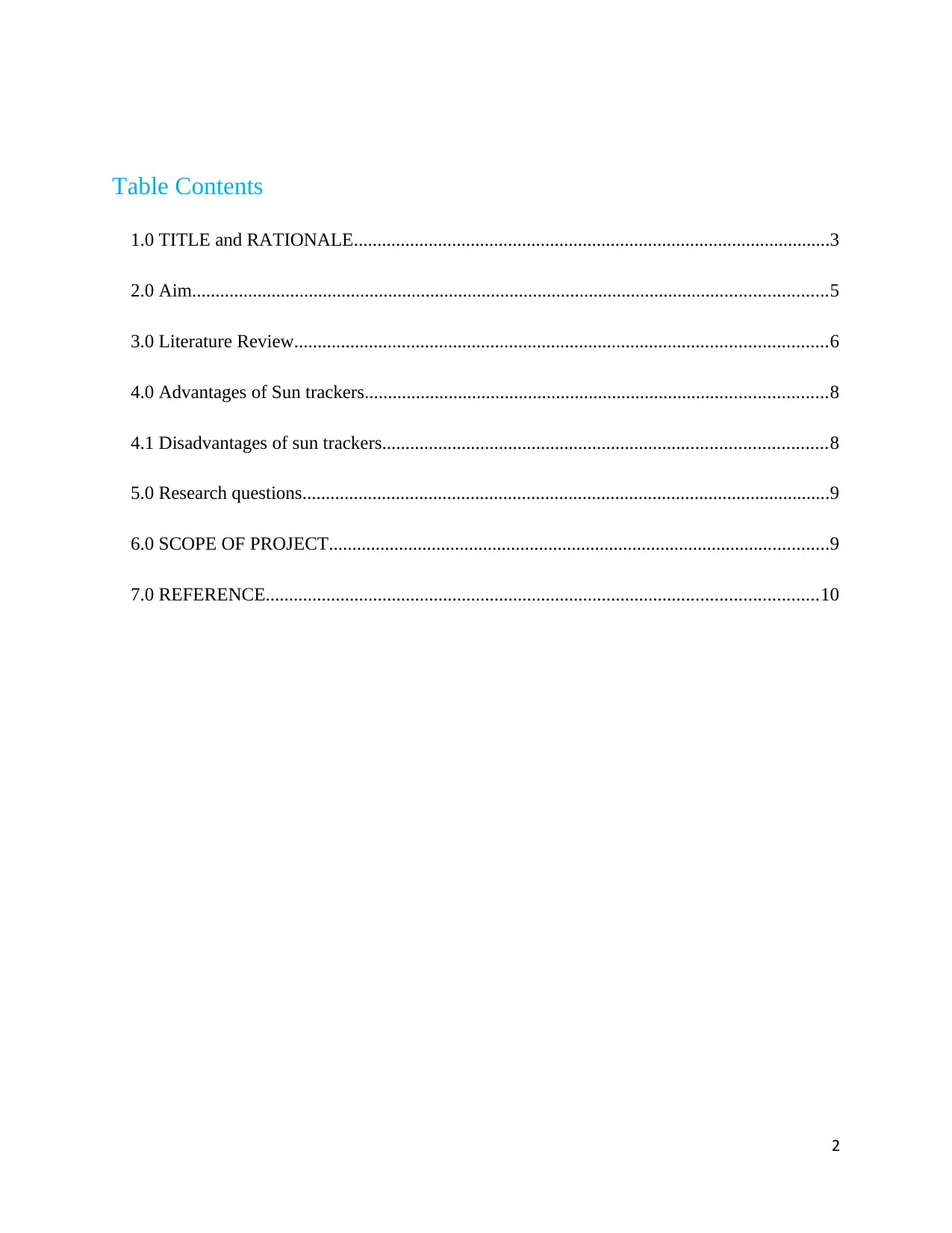
Table Contents
1.0 TITLE and RATIONALE......................................................................................................3
2.0 Aim........................................................................................................................................5
3.0 Literature Review..................................................................................................................6
4.0 Advantages of Sun trackers...................................................................................................8
4.1 Disadvantages of sun trackers...............................................................................................8
5.0 Research questions.................................................................................................................9
6.0 SCOPE OF PROJECT...........................................................................................................9
7.0 REFERENCE......................................................................................................................10
2
1.0 TITLE and RATIONALE......................................................................................................3
2.0 Aim........................................................................................................................................5
3.0 Literature Review..................................................................................................................6
4.0 Advantages of Sun trackers...................................................................................................8
4.1 Disadvantages of sun trackers...............................................................................................8
5.0 Research questions.................................................................................................................9
6.0 SCOPE OF PROJECT...........................................................................................................9
7.0 REFERENCE......................................................................................................................10
2
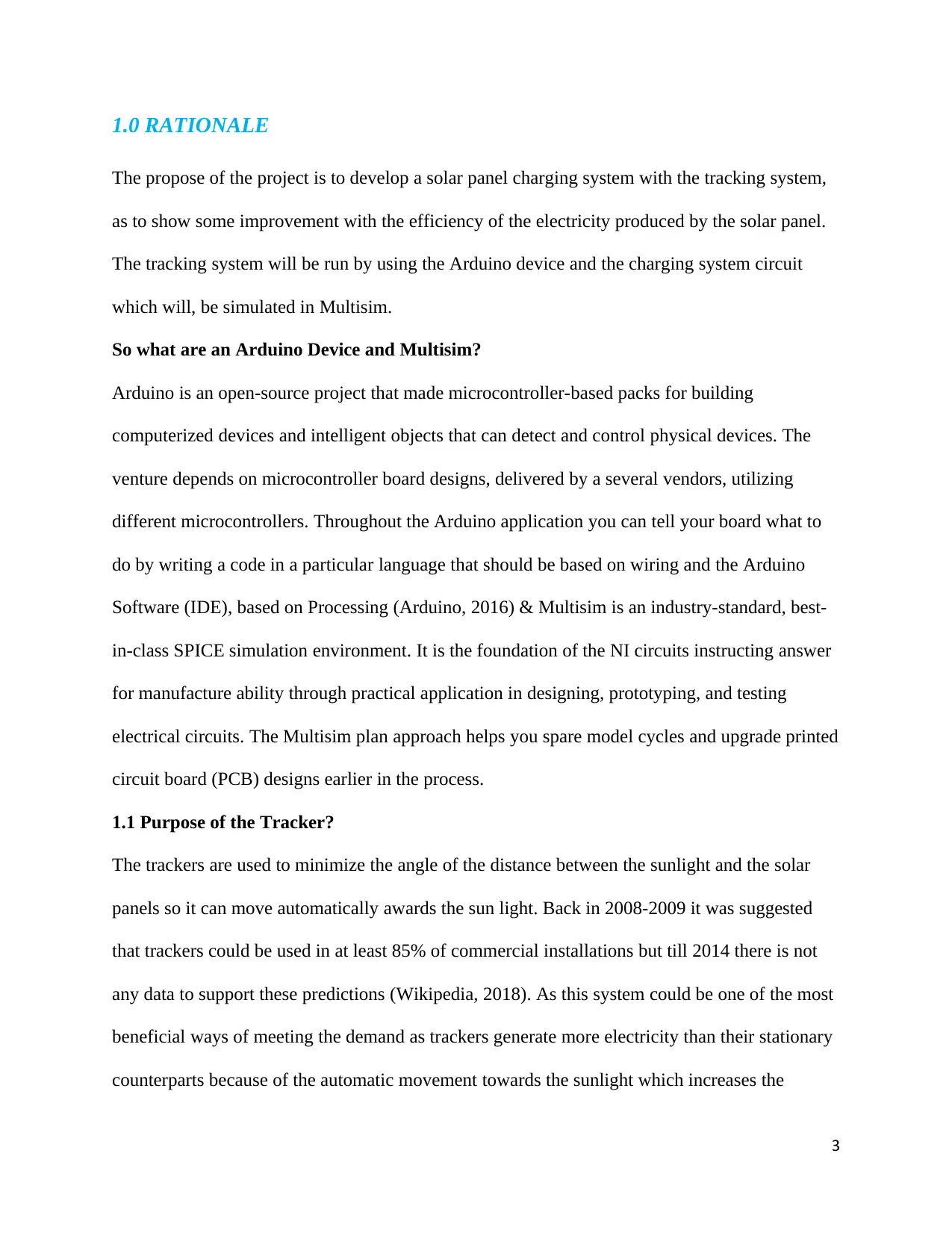
1.0 RATIONALE
The propose of the project is to develop a solar panel charging system with the tracking system,
as to show some improvement with the efficiency of the electricity produced by the solar panel.
The tracking system will be run by using the Arduino device and the charging system circuit
which will, be simulated in Multisim.
So what are an Arduino Device and Multisim?
Arduino is an open-source project that made microcontroller-based packs for building
computerized devices and intelligent objects that can detect and control physical devices. The
venture depends on microcontroller board designs, delivered by a several vendors, utilizing
different microcontrollers. Throughout the Arduino application you can tell your board what to
do by writing a code in a particular language that should be based on wiring and the Arduino
Software (IDE), based on Processing (Arduino, 2016) & Multisim is an industry-standard, best-
in-class SPICE simulation environment. It is the foundation of the NI circuits instructing answer
for manufacture ability through practical application in designing, prototyping, and testing
electrical circuits. The Multisim plan approach helps you spare model cycles and upgrade printed
circuit board (PCB) designs earlier in the process.
1.1 Purpose of the Tracker?
The trackers are used to minimize the angle of the distance between the sunlight and the solar
panels so it can move automatically awards the sun light. Back in 2008-2009 it was suggested
that trackers could be used in at least 85% of commercial installations but till 2014 there is not
any data to support these predictions (Wikipedia, 2018). As this system could be one of the most
beneficial ways of meeting the demand as trackers generate more electricity than their stationary
counterparts because of the automatic movement towards the sunlight which increases the
3
The propose of the project is to develop a solar panel charging system with the tracking system,
as to show some improvement with the efficiency of the electricity produced by the solar panel.
The tracking system will be run by using the Arduino device and the charging system circuit
which will, be simulated in Multisim.
So what are an Arduino Device and Multisim?
Arduino is an open-source project that made microcontroller-based packs for building
computerized devices and intelligent objects that can detect and control physical devices. The
venture depends on microcontroller board designs, delivered by a several vendors, utilizing
different microcontrollers. Throughout the Arduino application you can tell your board what to
do by writing a code in a particular language that should be based on wiring and the Arduino
Software (IDE), based on Processing (Arduino, 2016) & Multisim is an industry-standard, best-
in-class SPICE simulation environment. It is the foundation of the NI circuits instructing answer
for manufacture ability through practical application in designing, prototyping, and testing
electrical circuits. The Multisim plan approach helps you spare model cycles and upgrade printed
circuit board (PCB) designs earlier in the process.
1.1 Purpose of the Tracker?
The trackers are used to minimize the angle of the distance between the sunlight and the solar
panels so it can move automatically awards the sun light. Back in 2008-2009 it was suggested
that trackers could be used in at least 85% of commercial installations but till 2014 there is not
any data to support these predictions (Wikipedia, 2018). As this system could be one of the most
beneficial ways of meeting the demand as trackers generate more electricity than their stationary
counterparts because of the automatic movement towards the sunlight which increases the
3
⊘ This is a preview!⊘
Do you want full access?
Subscribe today to unlock all pages.

Trusted by 1+ million students worldwide
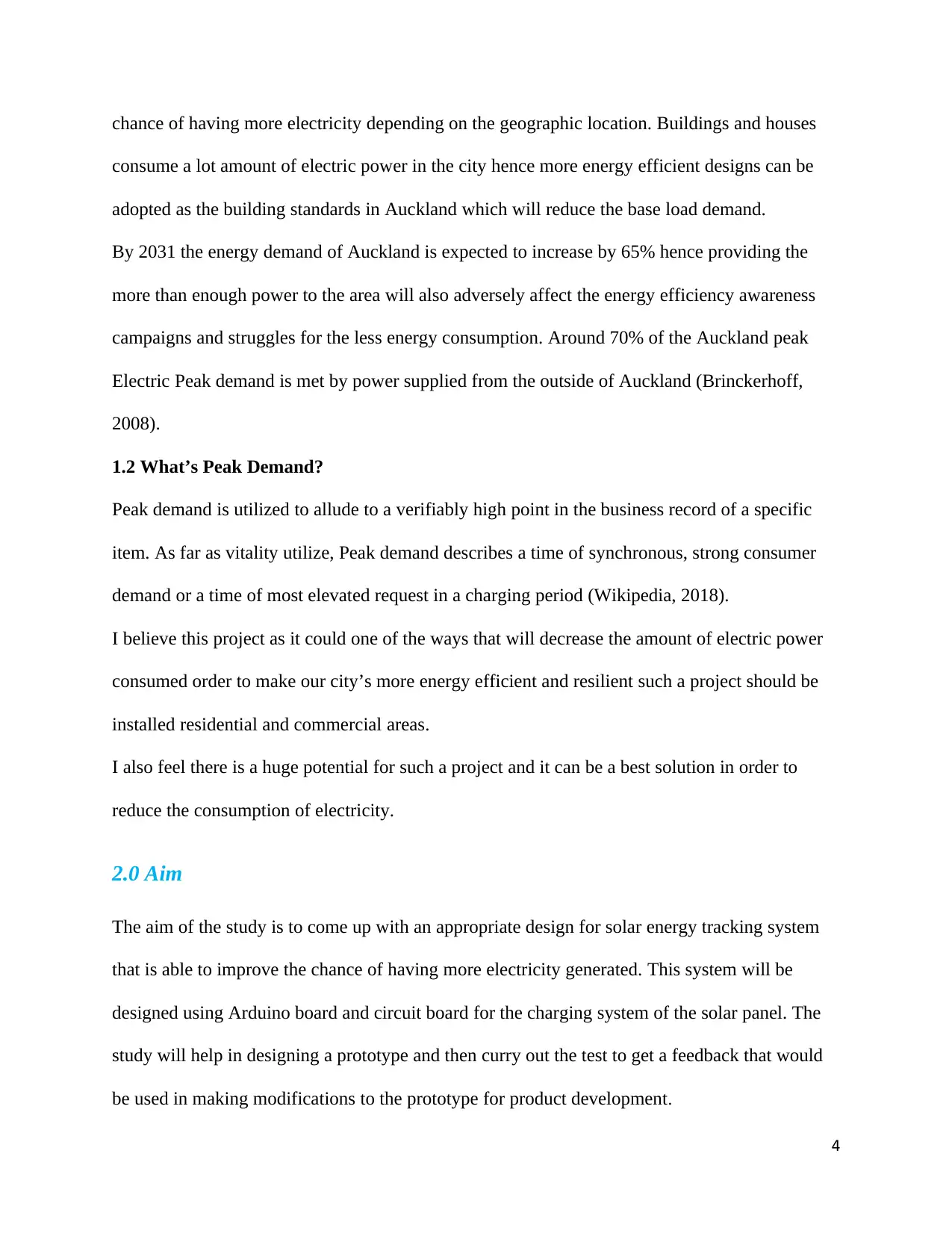
chance of having more electricity depending on the geographic location. Buildings and houses
consume a lot amount of electric power in the city hence more energy efficient designs can be
adopted as the building standards in Auckland which will reduce the base load demand.
By 2031 the energy demand of Auckland is expected to increase by 65% hence providing the
more than enough power to the area will also adversely affect the energy efficiency awareness
campaigns and struggles for the less energy consumption. Around 70% of the Auckland peak
Electric Peak demand is met by power supplied from the outside of Auckland (Brinckerhoff,
2008).
1.2 What’s Peak Demand?
Peak demand is utilized to allude to a verifiably high point in the business record of a specific
item. As far as vitality utilize, Peak demand describes a time of synchronous, strong consumer
demand or a time of most elevated request in a charging period (Wikipedia, 2018).
I believe this project as it could one of the ways that will decrease the amount of electric power
consumed order to make our city’s more energy efficient and resilient such a project should be
installed residential and commercial areas.
I also feel there is a huge potential for such a project and it can be a best solution in order to
reduce the consumption of electricity.
2.0 Aim
The aim of the study is to come up with an appropriate design for solar energy tracking system
that is able to improve the chance of having more electricity generated. This system will be
designed using Arduino board and circuit board for the charging system of the solar panel. The
study will help in designing a prototype and then curry out the test to get a feedback that would
be used in making modifications to the prototype for product development.
4
consume a lot amount of electric power in the city hence more energy efficient designs can be
adopted as the building standards in Auckland which will reduce the base load demand.
By 2031 the energy demand of Auckland is expected to increase by 65% hence providing the
more than enough power to the area will also adversely affect the energy efficiency awareness
campaigns and struggles for the less energy consumption. Around 70% of the Auckland peak
Electric Peak demand is met by power supplied from the outside of Auckland (Brinckerhoff,
2008).
1.2 What’s Peak Demand?
Peak demand is utilized to allude to a verifiably high point in the business record of a specific
item. As far as vitality utilize, Peak demand describes a time of synchronous, strong consumer
demand or a time of most elevated request in a charging period (Wikipedia, 2018).
I believe this project as it could one of the ways that will decrease the amount of electric power
consumed order to make our city’s more energy efficient and resilient such a project should be
installed residential and commercial areas.
I also feel there is a huge potential for such a project and it can be a best solution in order to
reduce the consumption of electricity.
2.0 Aim
The aim of the study is to come up with an appropriate design for solar energy tracking system
that is able to improve the chance of having more electricity generated. This system will be
designed using Arduino board and circuit board for the charging system of the solar panel. The
study will help in designing a prototype and then curry out the test to get a feedback that would
be used in making modifications to the prototype for product development.
4
Paraphrase This Document
Need a fresh take? Get an instant paraphrase of this document with our AI Paraphraser
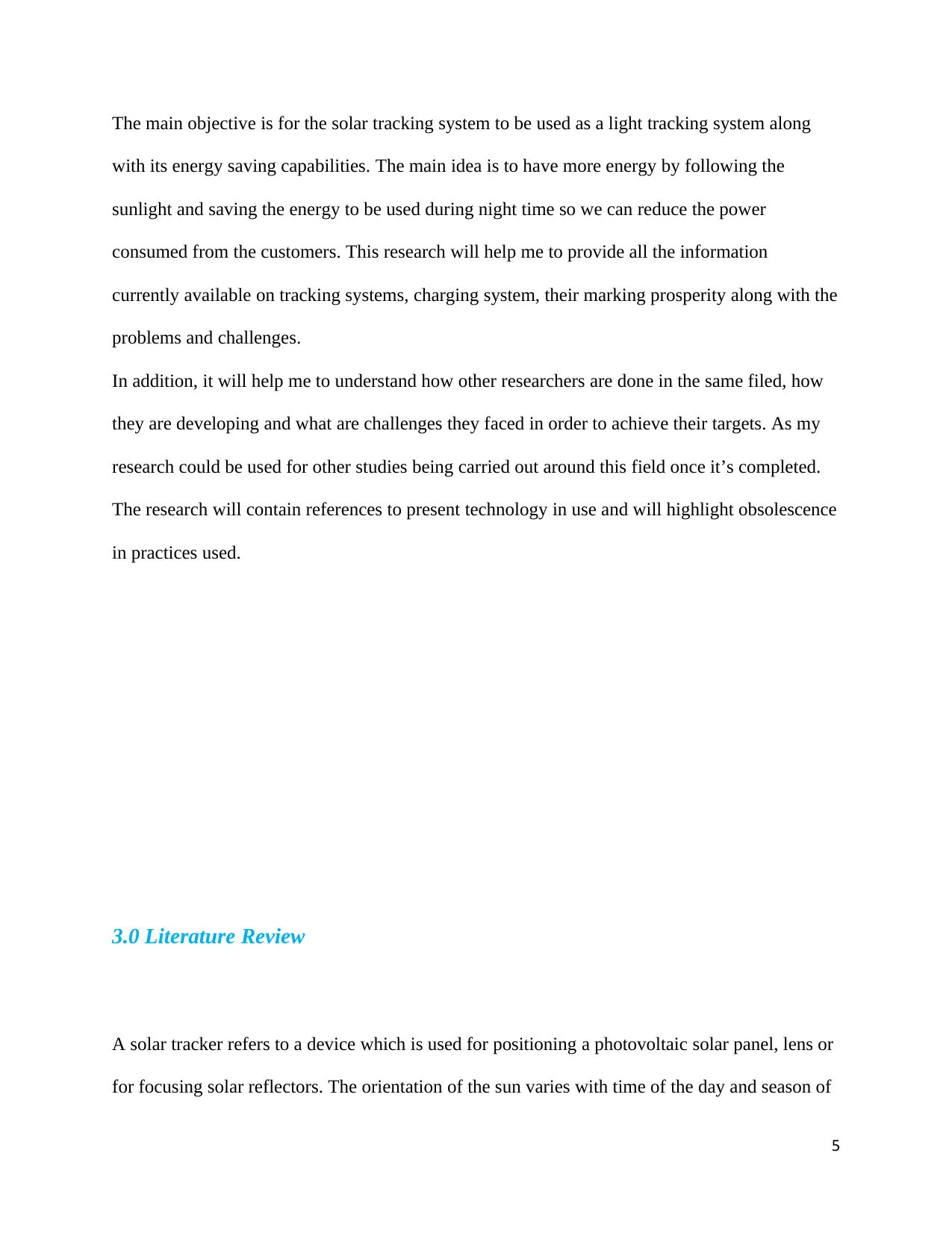
The main objective is for the solar tracking system to be used as a light tracking system along
with its energy saving capabilities. The main idea is to have more energy by following the
sunlight and saving the energy to be used during night time so we can reduce the power
consumed from the customers. This research will help me to provide all the information
currently available on tracking systems, charging system, their marking prosperity along with the
problems and challenges.
In addition, it will help me to understand how other researchers are done in the same filed, how
they are developing and what are challenges they faced in order to achieve their targets. As my
research could be used for other studies being carried out around this field once it’s completed.
The research will contain references to present technology in use and will highlight obsolescence
in practices used.
3.0 Literature Review
A solar tracker refers to a device which is used for positioning a photovoltaic solar panel, lens or
for focusing solar reflectors. The orientation of the sun varies with time of the day and season of
5
with its energy saving capabilities. The main idea is to have more energy by following the
sunlight and saving the energy to be used during night time so we can reduce the power
consumed from the customers. This research will help me to provide all the information
currently available on tracking systems, charging system, their marking prosperity along with the
problems and challenges.
In addition, it will help me to understand how other researchers are done in the same filed, how
they are developing and what are challenges they faced in order to achieve their targets. As my
research could be used for other studies being carried out around this field once it’s completed.
The research will contain references to present technology in use and will highlight obsolescence
in practices used.
3.0 Literature Review
A solar tracker refers to a device which is used for positioning a photovoltaic solar panel, lens or
for focusing solar reflectors. The orientation of the sun varies with time of the day and season of
5
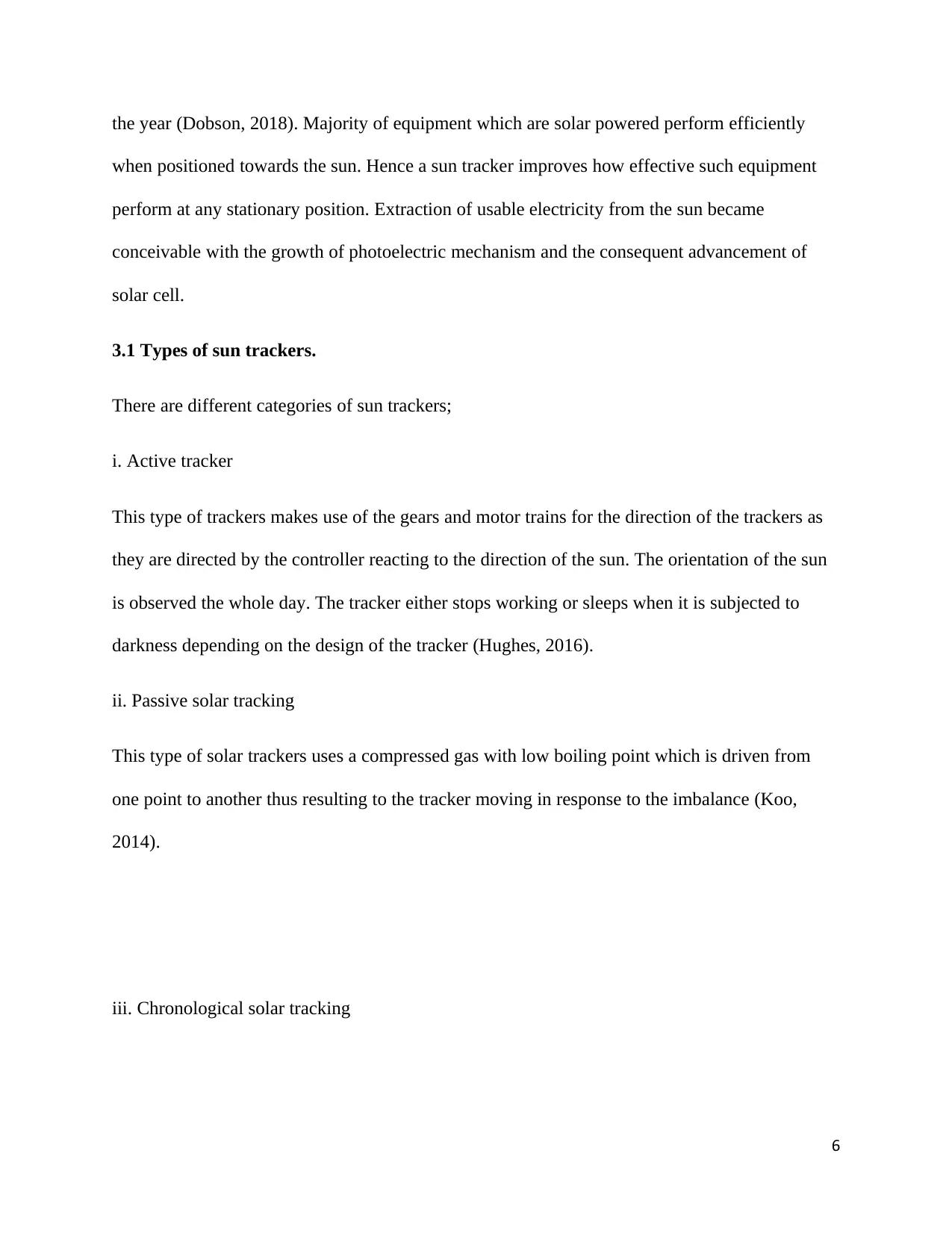
the year (Dobson, 2018). Majority of equipment which are solar powered perform efficiently
when positioned towards the sun. Hence a sun tracker improves how effective such equipment
perform at any stationary position. Extraction of usable electricity from the sun became
conceivable with the growth of photoelectric mechanism and the consequent advancement of
solar cell.
3.1 Types of sun trackers.
There are different categories of sun trackers;
i. Active tracker
This type of trackers makes use of the gears and motor trains for the direction of the trackers as
they are directed by the controller reacting to the direction of the sun. The orientation of the sun
is observed the whole day. The tracker either stops working or sleeps when it is subjected to
darkness depending on the design of the tracker (Hughes, 2016).
ii. Passive solar tracking
This type of solar trackers uses a compressed gas with low boiling point which is driven from
one point to another thus resulting to the tracker moving in response to the imbalance (Koo,
2014).
iii. Chronological solar tracking
6
when positioned towards the sun. Hence a sun tracker improves how effective such equipment
perform at any stationary position. Extraction of usable electricity from the sun became
conceivable with the growth of photoelectric mechanism and the consequent advancement of
solar cell.
3.1 Types of sun trackers.
There are different categories of sun trackers;
i. Active tracker
This type of trackers makes use of the gears and motor trains for the direction of the trackers as
they are directed by the controller reacting to the direction of the sun. The orientation of the sun
is observed the whole day. The tracker either stops working or sleeps when it is subjected to
darkness depending on the design of the tracker (Hughes, 2016).
ii. Passive solar tracking
This type of solar trackers uses a compressed gas with low boiling point which is driven from
one point to another thus resulting to the tracker moving in response to the imbalance (Koo,
2014).
iii. Chronological solar tracking
6
⊘ This is a preview!⊘
Do you want full access?
Subscribe today to unlock all pages.

Trusted by 1+ million students worldwide
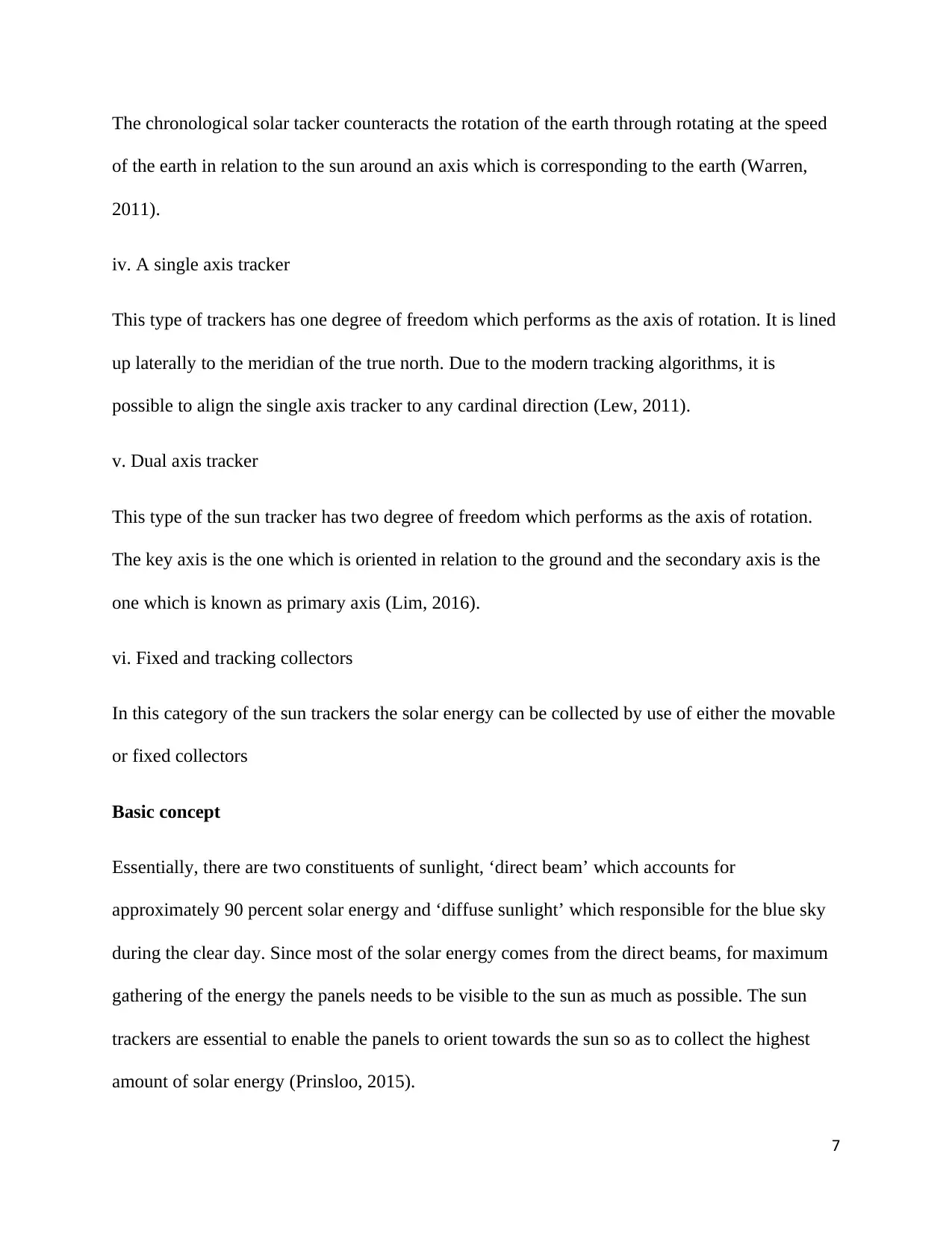
The chronological solar tacker counteracts the rotation of the earth through rotating at the speed
of the earth in relation to the sun around an axis which is corresponding to the earth (Warren,
2011).
iv. A single axis tracker
This type of trackers has one degree of freedom which performs as the axis of rotation. It is lined
up laterally to the meridian of the true north. Due to the modern tracking algorithms, it is
possible to align the single axis tracker to any cardinal direction (Lew, 2011).
v. Dual axis tracker
This type of the sun tracker has two degree of freedom which performs as the axis of rotation.
The key axis is the one which is oriented in relation to the ground and the secondary axis is the
one which is known as primary axis (Lim, 2016).
vi. Fixed and tracking collectors
In this category of the sun trackers the solar energy can be collected by use of either the movable
or fixed collectors
Basic concept
Essentially, there are two constituents of sunlight, ‘direct beam’ which accounts for
approximately 90 percent solar energy and ‘diffuse sunlight’ which responsible for the blue sky
during the clear day. Since most of the solar energy comes from the direct beams, for maximum
gathering of the energy the panels needs to be visible to the sun as much as possible. The sun
trackers are essential to enable the panels to orient towards the sun so as to collect the highest
amount of solar energy (Prinsloo, 2015).
7
of the earth in relation to the sun around an axis which is corresponding to the earth (Warren,
2011).
iv. A single axis tracker
This type of trackers has one degree of freedom which performs as the axis of rotation. It is lined
up laterally to the meridian of the true north. Due to the modern tracking algorithms, it is
possible to align the single axis tracker to any cardinal direction (Lew, 2011).
v. Dual axis tracker
This type of the sun tracker has two degree of freedom which performs as the axis of rotation.
The key axis is the one which is oriented in relation to the ground and the secondary axis is the
one which is known as primary axis (Lim, 2016).
vi. Fixed and tracking collectors
In this category of the sun trackers the solar energy can be collected by use of either the movable
or fixed collectors
Basic concept
Essentially, there are two constituents of sunlight, ‘direct beam’ which accounts for
approximately 90 percent solar energy and ‘diffuse sunlight’ which responsible for the blue sky
during the clear day. Since most of the solar energy comes from the direct beams, for maximum
gathering of the energy the panels needs to be visible to the sun as much as possible. The sun
trackers are essential to enable the panels to orient towards the sun so as to collect the highest
amount of solar energy (Prinsloo, 2015).
7
Paraphrase This Document
Need a fresh take? Get an instant paraphrase of this document with our AI Paraphraser
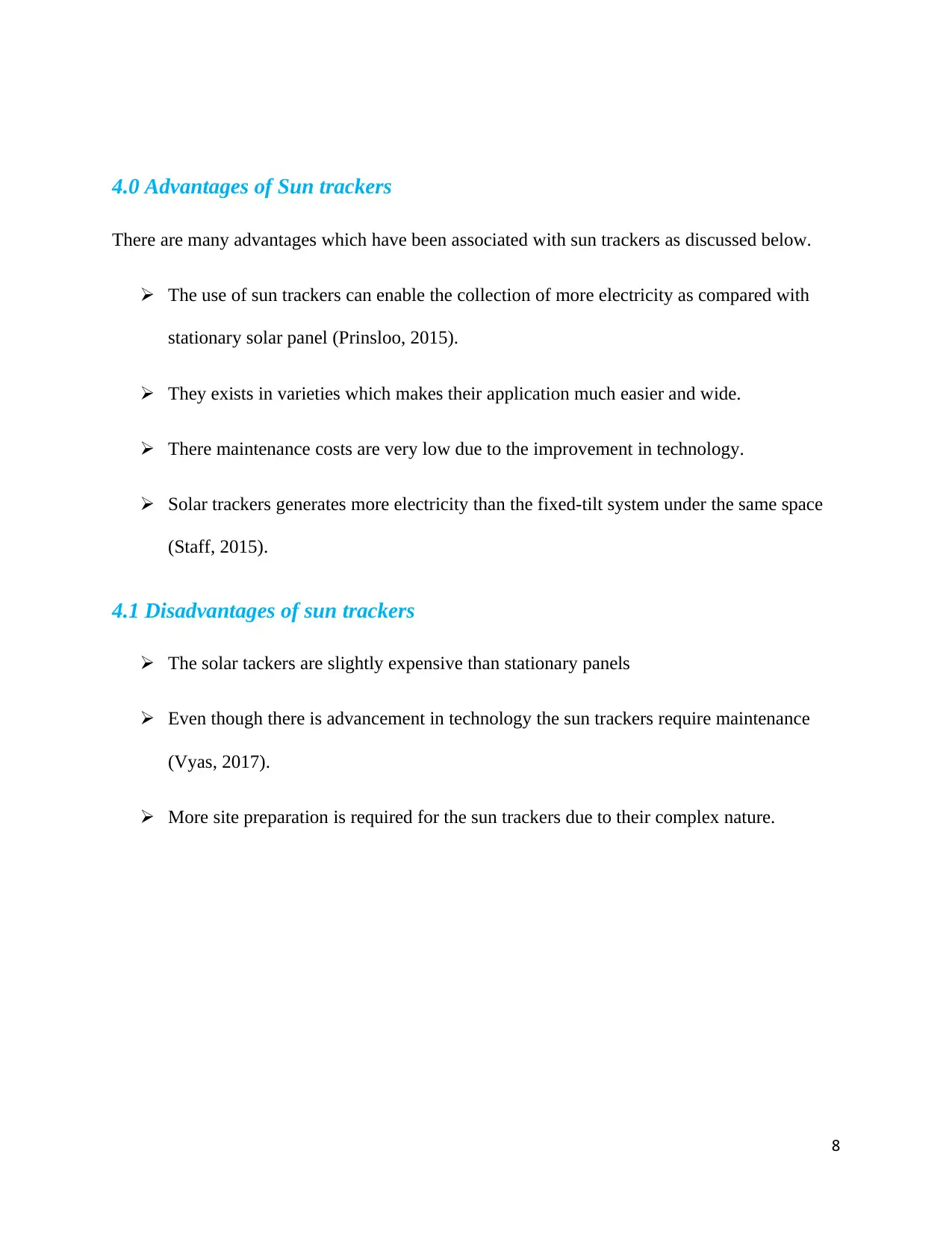
4.0 Advantages of Sun trackers
There are many advantages which have been associated with sun trackers as discussed below.
The use of sun trackers can enable the collection of more electricity as compared with
stationary solar panel (Prinsloo, 2015).
They exists in varieties which makes their application much easier and wide.
There maintenance costs are very low due to the improvement in technology.
Solar trackers generates more electricity than the fixed-tilt system under the same space
(Staff, 2015).
4.1 Disadvantages of sun trackers
The solar tackers are slightly expensive than stationary panels
Even though there is advancement in technology the sun trackers require maintenance
(Vyas, 2017).
More site preparation is required for the sun trackers due to their complex nature.
8
There are many advantages which have been associated with sun trackers as discussed below.
The use of sun trackers can enable the collection of more electricity as compared with
stationary solar panel (Prinsloo, 2015).
They exists in varieties which makes their application much easier and wide.
There maintenance costs are very low due to the improvement in technology.
Solar trackers generates more electricity than the fixed-tilt system under the same space
(Staff, 2015).
4.1 Disadvantages of sun trackers
The solar tackers are slightly expensive than stationary panels
Even though there is advancement in technology the sun trackers require maintenance
(Vyas, 2017).
More site preparation is required for the sun trackers due to their complex nature.
8
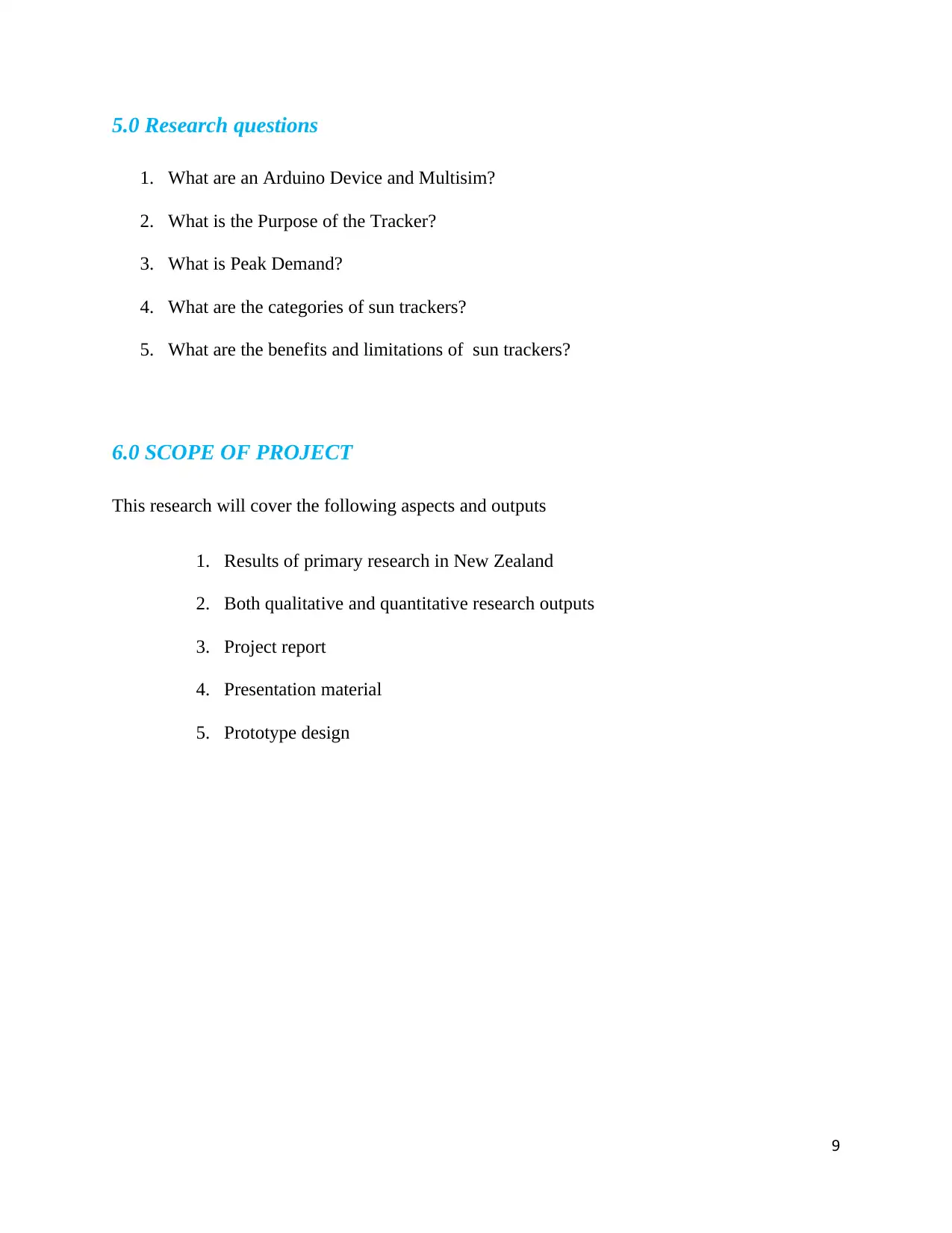
5.0 Research questions
1. What are an Arduino Device and Multisim?
2. What is the Purpose of the Tracker?
3. What is Peak Demand?
4. What are the categories of sun trackers?
5. What are the benefits and limitations of sun trackers?
6.0 SCOPE OF PROJECT
This research will cover the following aspects and outputs
1. Results of primary research in New Zealand
2. Both qualitative and quantitative research outputs
3. Project report
4. Presentation material
5. Prototype design
9
1. What are an Arduino Device and Multisim?
2. What is the Purpose of the Tracker?
3. What is Peak Demand?
4. What are the categories of sun trackers?
5. What are the benefits and limitations of sun trackers?
6.0 SCOPE OF PROJECT
This research will cover the following aspects and outputs
1. Results of primary research in New Zealand
2. Both qualitative and quantitative research outputs
3. Project report
4. Presentation material
5. Prototype design
9
⊘ This is a preview!⊘
Do you want full access?
Subscribe today to unlock all pages.

Trusted by 1+ million students worldwide
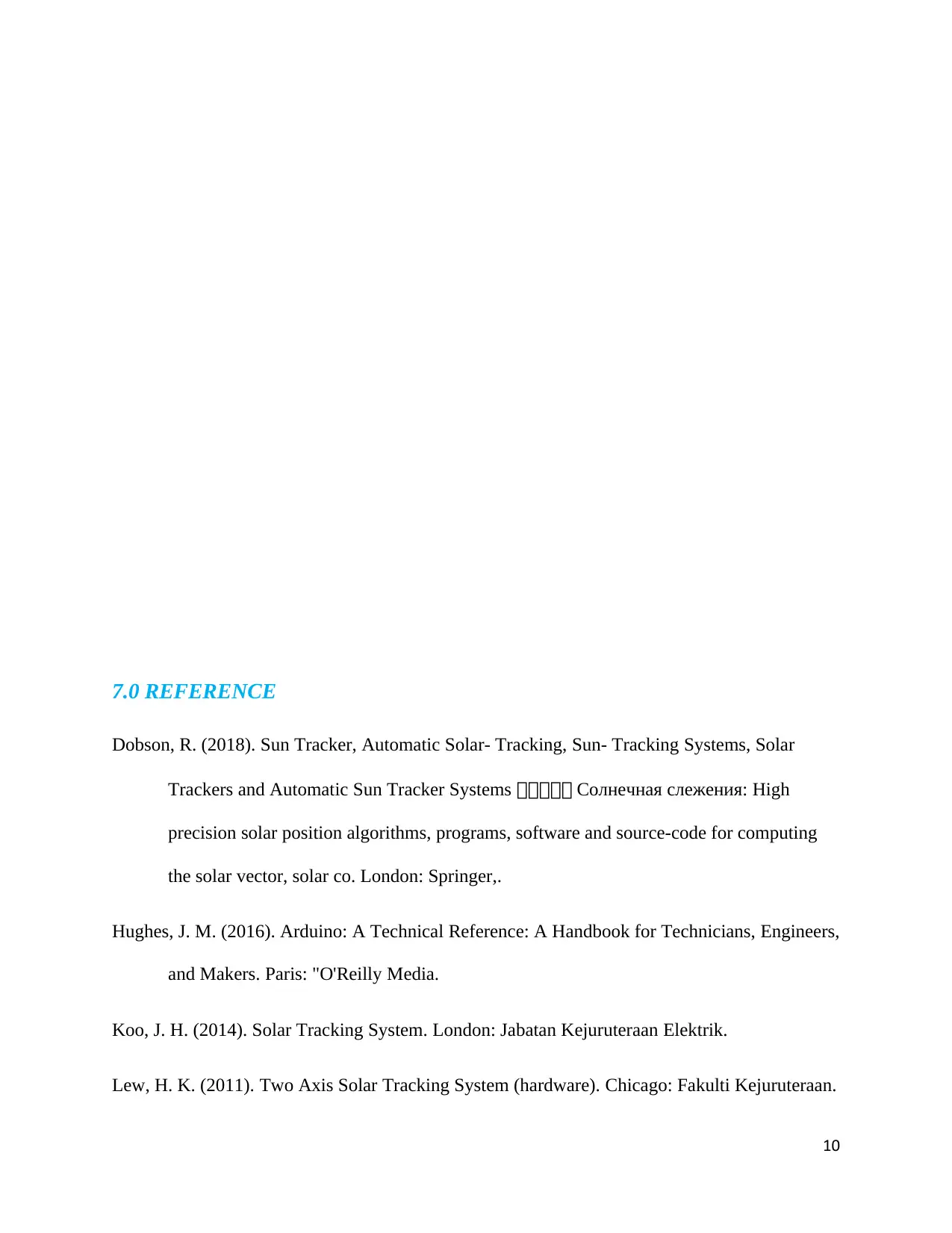
7.0 REFERENCE
Dobson, R. (2018). Sun Tracker, Automatic Solar- Tracking, Sun- Tracking Systems, Solar
Trackers and Automatic Sun Tracker Systems 太太太太太 Солнечная слежения: High
precision solar position algorithms, programs, software and source-code for computing
the solar vector, solar co. London: Springer,.
Hughes, J. M. (2016). Arduino: A Technical Reference: A Handbook for Technicians, Engineers,
and Makers. Paris: "O'Reilly Media.
Koo, J. H. (2014). Solar Tracking System. London: Jabatan Kejuruteraan Elektrik.
Lew, H. K. (2011). Two Axis Solar Tracking System (hardware). Chicago: Fakulti Kejuruteraan.
10
Dobson, R. (2018). Sun Tracker, Automatic Solar- Tracking, Sun- Tracking Systems, Solar
Trackers and Automatic Sun Tracker Systems 太太太太太 Солнечная слежения: High
precision solar position algorithms, programs, software and source-code for computing
the solar vector, solar co. London: Springer,.
Hughes, J. M. (2016). Arduino: A Technical Reference: A Handbook for Technicians, Engineers,
and Makers. Paris: "O'Reilly Media.
Koo, J. H. (2014). Solar Tracking System. London: Jabatan Kejuruteraan Elektrik.
Lew, H. K. (2011). Two Axis Solar Tracking System (hardware). Chicago: Fakulti Kejuruteraan.
10
Paraphrase This Document
Need a fresh take? Get an instant paraphrase of this document with our AI Paraphraser
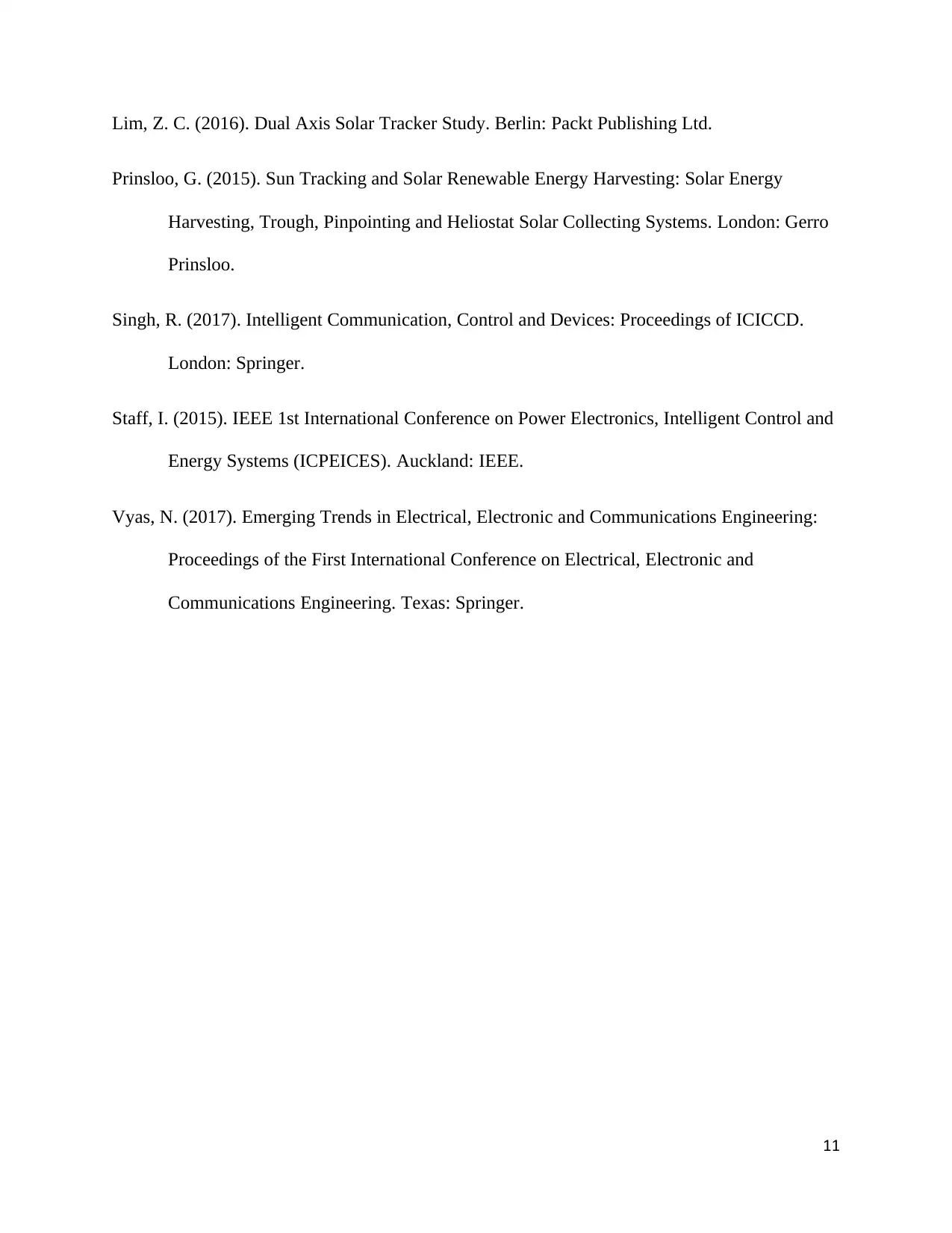
Lim, Z. C. (2016). Dual Axis Solar Tracker Study. Berlin: Packt Publishing Ltd.
Prinsloo, G. (2015). Sun Tracking and Solar Renewable Energy Harvesting: Solar Energy
Harvesting, Trough, Pinpointing and Heliostat Solar Collecting Systems. London: Gerro
Prinsloo.
Singh, R. (2017). Intelligent Communication, Control and Devices: Proceedings of ICICCD.
London: Springer.
Staff, I. (2015). IEEE 1st International Conference on Power Electronics, Intelligent Control and
Energy Systems (ICPEICES). Auckland: IEEE.
Vyas, N. (2017). Emerging Trends in Electrical, Electronic and Communications Engineering:
Proceedings of the First International Conference on Electrical, Electronic and
Communications Engineering. Texas: Springer.
11
Prinsloo, G. (2015). Sun Tracking and Solar Renewable Energy Harvesting: Solar Energy
Harvesting, Trough, Pinpointing and Heliostat Solar Collecting Systems. London: Gerro
Prinsloo.
Singh, R. (2017). Intelligent Communication, Control and Devices: Proceedings of ICICCD.
London: Springer.
Staff, I. (2015). IEEE 1st International Conference on Power Electronics, Intelligent Control and
Energy Systems (ICPEICES). Auckland: IEEE.
Vyas, N. (2017). Emerging Trends in Electrical, Electronic and Communications Engineering:
Proceedings of the First International Conference on Electrical, Electronic and
Communications Engineering. Texas: Springer.
11
1 out of 11
Related Documents
Your All-in-One AI-Powered Toolkit for Academic Success.
+13062052269
info@desklib.com
Available 24*7 on WhatsApp / Email
![[object Object]](/_next/static/media/star-bottom.7253800d.svg)
Unlock your academic potential
Copyright © 2020–2025 A2Z Services. All Rights Reserved. Developed and managed by ZUCOL.



